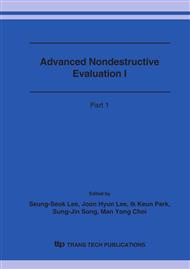p.290
p.294
p.298
p.302
p.306
p.310
p.314
p.318
p.322
The Effect of Joint Conditions on the Longitudinal and Flexural Wave Velocities of a Rock Mass
Abstract:
The behavior of a jointed rock is different from that of an intact rock, and the characteristics of elastic wave propagation in a jointed rock are different from those of an intact rock. In this study, a rock resonant column testing device is designed to measure the longitudinal and flexural wave velocities of jointed rocks under different states of stress. A column of more than 12 rock discs is stacked on a steel base, which acts as a free-fixed system. This configuration ensures that waves propagate under an equivalent continuum condition, thereby rendering a constant and unique velocity. The effect of joint conditions on the wave velocities is investigated through rock resonant column testings. The results show that velocities are sensitive to the state of stress and increase nonlinearly with stress. The velocities are also affected by joint conditions such as roughness, spacing, and filling. The results are useful for rock mass classification based on near-surface geophysical characterization.
Info:
Periodical:
Pages:
306-309
Citation:
Online since:
October 2006
Authors:
Price:
Сopyright:
© 2006 Trans Tech Publications Ltd. All Rights Reserved
Share:
Citation:


